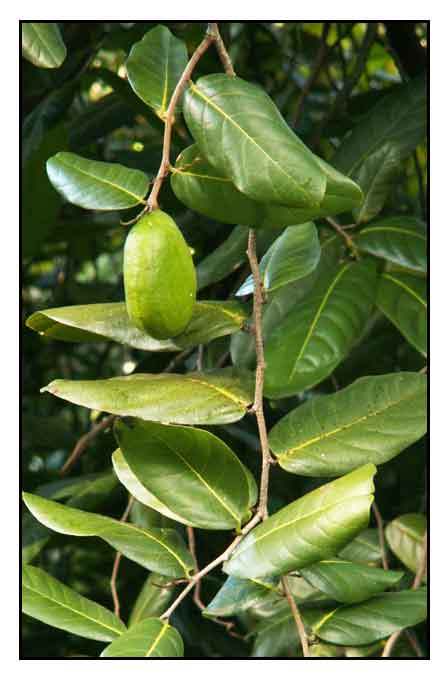 Botany Botany
Inocarpus fagifer is an evergreen tree growing to a eight of 20 m with a large and dense canopy. Bole is buttressed at the base, short, thick, irregular, up to 60 cm in diameter. Taproot is shallow with and well-formed network of lateral roots. Bark is rough and brown, increasing gray with age. Branches are spirally arranged, with secondary branches forming a dense network within the canopy. Leaves are dark green, simple, oblong and leathery. , 15 to 30 cm long, 7 to 13 cm wide, pointed apex and lobed base. Petiole is 5 mm long. Flowers are white, cream, or pale yellow, fragrant, and growing in clusters at the end of branches and twigs. Fruits are slightly flattened, irregularly ovoid, rounded or oblong, and flanged at one end, 4 cm to 13 cm long, 3 to 12 cm wide, occurring singly or in clusters. Seed is white, kidney-shaped, 2 to 7 cm long and 1.6 to 4 cm wide.(3) (4)
Distribution
- Introduced.
- Found from Malaysia to Australia and the southwest Pacific.
Constituents
- Study for the fatty acids, minerals, phenolics, and vitamin contents yielded a slight predominance of unsaturated over saturated fatty acids. Mineral analysis yielded substantial concentrations of copper, magnesium, manganese, potassium and zinc with 19.32, 1823.21, 8.44, 23308.41 and 77.99 mg/kg of dry matter, respectively. Ferulic and coumaric acids were the most abundant phenolics (3.23 and 1.48 mg/kg DM, respectively. Flavonoids, isofavonoids and coumestrol were present. Vitamins niacin and riboflavin were 131.80 and 4.47 mg/kg DM. (5)
Properties
- Studies have suggested nutritional, antioxidant. antiatherosclerotic properties.
Parts used
Bark, leaves, seeds..
 Uses Uses
Edibility
- Seeds are edible, raw or cooked. Boiled before ripening , they have the flavor of chestnut.(3)
- Seeds cooked by roasting, grilling, boiling, and baking. In Papua New Guin ea, Solomon Islands and in Polynesia, cooked kernels are mashed into a pudding. (4)
- Caution: The seed is reported by some as toxic when raw, but edible when cooked.
(4)
- Grated seeds used for making cakes, breads and pudding. However, kernels are reportedly slightly indigestible, and when cooked, is highly perishable with a short shelf-life.(3)
Folkloric
- No reported medicinal use in the Philippines.
- Elsewhere, use for the treatment of burns, diarrhea, scabies, teething problems in infants, pneumonia,, stomach pains, bone pains, malarial fever and internal bleeding.
Dried bark mixed with coconut oil applied to bone fractures. (3)
Others
- Thatching: Leaves used for thatching. (4)
- Fuel: Branches used as firewood. Green wood burned to dry copra. (4)
- Crafts: Wood used for carving and making tool handles, canoes, and various light construction. (4)
- Agroforestry: Trees in coastal and soil stabilization; used as shade-tree or windbreaker. (4)
- Superstition / Mythology: In Samoa, humans believed to ave originated from the chestnut tree. In Vanuatu, the first woman was a man emasculated by hot leaves applied to the genitalia. (4)
 Studies Studies
• Fatty Acids / Phenolics / Minerals / Vitamins: Study reported on the fatty acids, phenolics, and vitamin content of Inocarpus fagifer. Results yielded a slight predominance of unsaturated over saturated fatty acids. Mineral analysis yielded substantial concentrations of copper, magnesium, manganese, potassium and zinc with 19.32, 1823.21, 8.44, 23308.41 and 77.99 mg/kg of dry matter, respectively. Ferulic and coumaric acids were the most abundant phenolics (3.23 and 1.48 mg/kg DM, respectively. Flavonoids, isofavonoids and coumestrol were present. Vitamins niacin and riboflavin were 131.80 and 4.47 mg/kg DM. (5)
• Antioxidant / Seeds: Study evaluated the antioxidant compounds i.e., linoleic acid, ethyl linoleic, ethyl oleic, and homoptero carpine in an ethanol extract of gayam seed to prevent atherosclerosis through increase of SOD3 expression and decrease of MDA concentration in Wistar rats with high cholesterol. Results showed the ethanol extracts in doses of 50-150 mg/kbw significantly increased SOD expression in aorta endothelial cells and significantly decreased MDA (p<0.05). (6)
• Antiatherosclerotic Effect in Hyperlipidemic Rats: Study evaluated the anti-atherosclerotic effect of n-butanol extract of stem bark through biomaker SOS-2 and SOD-3 expression in aortic endothelial cell of hypercholesterolemic wistar rats. At dose of 50 mg/kbw there was significant (p<0.05) increased expression of SOD-2 aortic endothelial cells. The SOD-3 effect was not significant )P>0.05). (7)
• Effect of Pre-Gelatiinization on Physiochemical and Functional Properties of Gayam Flour: Study on pre-gelatinization treatment pf gayam flour. Results showed significant differences in physiochemical and functional properties in pre-gelatinized flour with respect to starch, amylose content, color, microstructure, water holding capacity, oil holding capacity and pasting properties. Pre-gelatinization increased the whiteness index, water holding capacity and swelling power. (9)
Availability
- Wild-crafted.
- Cultivated for its edible seeds.
- Seeds in the cybermarket.
|

![]()



 Botany
Botany Uses
Uses Studies
Studies 